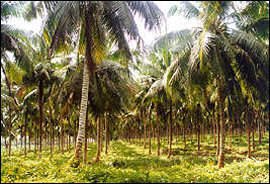 Climate Climate |

As far as the climate is concerned, one remarks that the country is swept across by two major drifting masses of air: a mass of air coming from. the North, characterized by a dry, hot wind loaded with the fine particles of the harmattan, from December to January; a mass of air coming from. the South-West, from. the Atlantic Ocean, constitued by a moist air. The contact of both these masses forms the Inter-Tropical Front (ITF), which results in monsoon type rainfalls. The seasonal drifts of the ITF over the national territory allows to make out four main climatic areas, characterized by a place and volume of variable rainfalls.
These areas are:
-the South, with four seasons, of which one long rainy season from April to July, a short dry season from July to September, a short rainy season from. September to November, and a long dry season from. December to March;
-the Center, featured by a dry season from November
to March, and a season marked by two maximum rainfalls:
one in June and the other one in September; |
-the North with two very opposite seasons: a very long dry season and a fairly short rainy season (June-September);
-the Central-West with its mountainous relief, is distinguishable by a very long rainy season and a short lived dry season.
The average annual rainfalls of these different climatic areas range from. 900 mm (in the North) to 2,300 mm (in the South).
In matter of temperature, one notices that the most important diurnal increases take place in January. They stand under 10°C in the South forested-area, average 15°C in the Center and sometimes reach 20°C in the North.
The country's average temperature ranges from. 25°C to 26°C in the South and the Center, from. 26°C to 26,5°C in the North-East and 24°C in the West.
 HYDROGRAPHY HYDROGRAPHY |
As far as hydrography is concerned, one notices
that the Côte d'Ivoire is drained by four
large rivers that run the North to the South before
flowing into the sea. They are the Cavally and the
Sassandra in the West, the Bandama in the Center
and the Comoe in the East. The first two rivers
are the shorter ones with 700 km (Cavally) and 600
km (Sassandra). As for the Bandama and the Comoe
which are the longer ones, they are respectively
1'050 km and 1'160 km long. |

